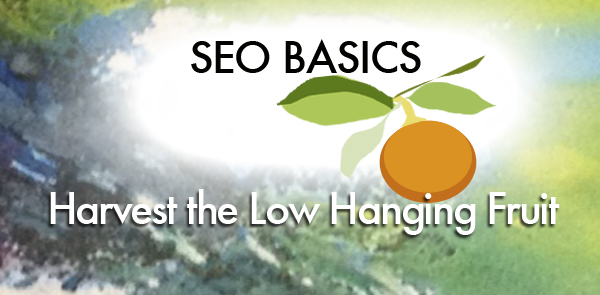To many small business owners and sole proprietors, Search Engine Optimization (SEO) is a bit of a mystery or they believe it is too complicated and expensive to get into. As there is truly an almost endless list of things that can be done to maximize SEO, in my experience it becomes an unnecessarily daunting project and many leave it alone completely rather than take even a ‘something is better than nothing’ approach.
Harvest Low Hanging Fruit for SEO Quick Wins
It is really quite simple – it is all about helping search engines understand what your site is authentically about, so they may confidently recommend it where it is most appropriate to users who are looking for exactly your type of information, service or product.
There are many things you can do to help Google and other search engines understand that your pages are relevant, and where they should serve them up on a SERP (search engine results page) as a recommended link when they match a user’s search. Search Engines use robots to ‘crawl’ your site, read through every word and element on each page, and record the detail to prepare an index of it’s content. They utilize complicated and increasingly more sophisticated algorithms to weigh the relevance of a multitude of factors in order to determine if your site is relevant to a particular search query. Many experts may tell you they know exactly how those algorithms work. However, no one but the authors actually do. A lot of testing and surmising goes on to come to broadly accepted educated guesses. In Google’s own words “Be relevant, be compelling and drive traffic to landing pages that deliver on what you promise” and “Do what’s best for your users and your bottom line, and all else will (or at least should) follow.”
How do you eat an elephant? …One Bite at a time!
Improvements can be made onsite and off; from page load, to keywords, to tags, to strategic social media activity, inbound link building and beyond. A great deal of time and budget can easily be spent on perpetually improving target and rank. However, it consistently surprises me to see how many SMB sites are missing just the basics.
The average sole proprietor or SMB owner does not have a huge budget for ads, extra staff or a lot of time to attend to prolific and strategic Social Media, media relations, blogging, guest blogging, or to contract ongoing sophisticated SEO optimization attention and Adwords management for their site. For those who want to do the best they can with limited time and budget resources, my advice is always be consistent and be authentic – don’t try to ‘game the system’ and do run away from promises of, “I can get you on the first page of Google search results tomorrow”. The algorithms are increasingly complicated and ‘smart’ which makes it more and more important to be authentic when you are creating content and optimizing. You may try these sketchy services, and you may well get on the first page tomorrow as promised. However, too often the day after or the week after that, you will find your site eradicated from the listings entirely.
There are so many straight forward little improvements, which in my experience far too many SMBs miss out on and do not harvest this low hanging fruit because they assume it is too expensive and complicated to address SEO. Most are very straight forward for the average site owner to DIY as long as you have control over, and access to basic editing tools for your site (which is also remarkably uncommon amongst many SMBs). When addressed, though it is not all that you can do, covering the basics can make a big difference to Boost your SERP (Search Engine Results Page) ranking, incoming traffic, engagement and grow your email list.
Search Engine Optimization is not about hanging your hat on one particular keyword phrase, tweaking some code and buying ads. The search engines are fundamentally looking at the quality of your content, its popularity and authority. Authority takes some concerted effort to increase, but address the quality with a holistic approach to optimizing your site, even if only at basic level and that will help you rise closer to or even above your competition (who is often not attending to many of these basics). Often a competitor’s success may not come from these same best practices but from having lots of good backlinks and social signals. Even if you are not actively and consistently building on those strengths, attending to a thoughtful processand basic best practices will help you make up for it. There are also many helpful resources for the DIY approach.
A few simple things you can do today to improve your basic SEO:
- Fresh content – Frequently added and updated, fresh, authentic, relevant and optimized content.
- CTA – Clear calls to action.
- Unique Title Tags – Optimize each page in your site for a unique keyword or phrase.
- Hyperlinks within your copy to make your site more easily to crawl and to keep users on your site longer, moving from page to page.
- Well placed keywords in Title, Meta Description, alt tags, H1, H2, First line of copy, and Page URL.
- Research – Do a little sleuthing to find what keyword phrases your top competitors are focusing on. Implement them where applicable and research other terms to utilize and capture the same audience’s attention even in the long tail (future post).
- Bold selected and important content
- Best practices in usability, accessibility and optimum site performance. Make your site as fast loading and easily crawl-able as possible throughout.
- Don’t ignore the Alt – Text captured within an image is lost to Search Engines but utilize the “Alt” tag for all images to tell them what the image is about and how it is relevant to the page
- If you are using WordPress, the Yoast SEO plugin is a very user friendly ‘follow the bouncing ball’ tool to help you optimize your pages.
- Create a Sitemap and submit to Google
- Grow your backlinks. Start gradually by building inbound links. Were possible, request authentic links from a resources page or content of sites from associates, suppliers and clients, look for relevant guest posting opportunities, increase social media activity to amplifying your content and drive traffic to your site.
- Don’t overuse keywords (also known as “keyword stuffing”).
- Don’t fake it, optimizing for keywords that are unrelated to the website contents.
- Don’t buy links
- Don’t duplicate content or use auto generated or scraped content.
Before you get excited to start working at improving your SEO and boost the traffic coming your site, be sure it is ready first. Make sure you have compelling calls to action, with plenty of well organized information that is clear and to the point, interesting images, obvious and easy to find contact information, and links to take the user from page to page so they keep exploring your site. Increasing traffic to a site that repels or confuses users is a waste of your time and budget.
So many places to expound on here, but for now I’ll keep it short and sweet. Contact me for help with keyword and competitive research, SEO implementation, or simply for further guidance and consultation on where and how to improve your website performance, reach and rank specific to your business niche.





